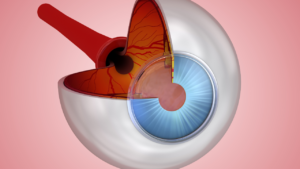January is Glaucoma Awareness Month

What is Glaucoma?
Glaucoma is the leading cause of vision loss, and affects more than 728,000 Canadians. The eye disease causes vision loss and blindness by damaging a nerve in the back of your eye called the optic nerve. This nerve acts like an electric cable with over a million wires and is responsible for carrying images from the eye to the brain.Although the most common forms primarily affect the middle-aged and the elderly, glaucoma can affect people of all ages.
What are the symptoms of glaucoma?
Glaucoma often doesn’t have any early symptoms, which is why it frequently goes undetected. Many people don’t realize they have glaucoma until they start losing their vision, usually starting with your side (peripheral) vision. Because it happens so slowly, many people can’t tell that their vision is changing at first. Glaucoma can develop in one or both eyes, and can eventually lead to blindness.Symptoms of glaucoma include:
- Loss of peripheral vision
- Halos around lights
- Eye pain and/or redness
- Blurred or decreased vision
- Eye pain
Types of Glaucoma
There are many different types of Glaucoma with the most common types being open-angle and angle-closure.Open-angle glaucoma is the most prevalent and the cause is unknown. It often goes unnoticed as the increase in eye pressure happens slowly over time and you can’t feel it. Eventually, the increased pressure pushes on the optic nerve until the damage causes blind spots in your vision. Your risk for open-angle glaucoma tends to be higher if it runs in your family.
Angle-closure glaucoma occurs when fluid in the eye is suddenly blocked and cannot flow out of the eye, causing a quick and severe rise in eye pressure. Angle-closure glaucoma comes on suddenly and painfully.
Both of these forms of glaucoma are marked by an increase of intraocular pressure (IOP), or pressure inside the eye. Normal tension glaucoma occurs when optic nerve damage has occurred despite a normal IOP.
Another type of glaucoma is secondary glaucoma. Both open- and closed-angle glaucoma can be secondary when caused by something known. Causes include:
- Medicines such as corticosteroids
- Eye diseases, such as uveitis (an inflammation of the middle layer of the eye)
- Diseases such as diabetes
- Eye injury
Can Glaucoma be treated?
There is no cure for glaucoma, but early treatment can often prevent further damage to the eyes. Treatments can include medicines (usually eye drops), laser treatment, and surgery. It’s important to note that glaucoma treatment won’t undo any damage already done to your vision.The only way to check for glaucoma is to get a comprehensive dilated eye exam. It’s important to schedule regular eye exams, so your ophthalmologist can assess your vision.
If diagnosed with glaucoma, your ophthalmologist is able to conduct a number of different tests and offer a more specific diagnosis, including:
- Visual acuity tests to assess your ability to see from different distances
- Visual field tests to measure your peripheral vision
- Dilated eye exams
- Ocular tonometry to measure the intraocular pressure inside your eye
- Pachymetry to measure

